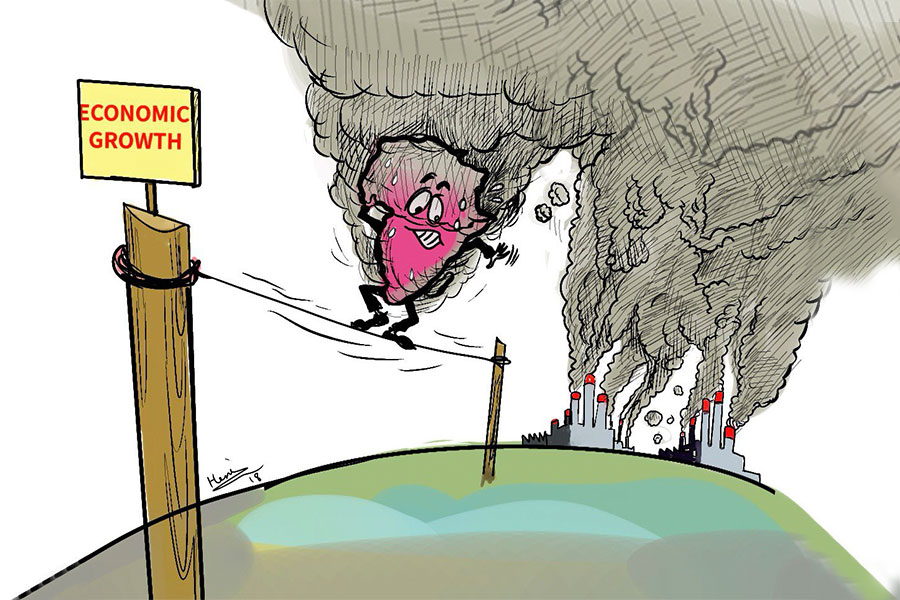
Photo Gallery | 156955 Views | May 06,2019
Sep 15 , 2025. By YITBAREK GETACHEW ( FORTUNE STAFF WRITER )
The Addis Abeba City Cabinet has enacted a landmark reform to its long-contentious setback regulations, a policy city officials say is meant to modernise urban governance and unlock long-stalled development. The decision, made public through an official circular issued on August 23, 2025, marks a sharp departure from a rigid legal regime that many property developers and experts have criticised as unworkable.
The revised law, now in force across the capital’s districts, comes after years of growing tension between the city administration and private property owners over plot eligibility, permit delays, and opaque development guidelines. The new regulation introduces flexibility for small and irregular plots, sets explicit tolerances for minor deviations, and, crucially, enforces a controversial clause requiring the merger of undersized plots with neighbouring properties.
City planners argue that the overhaul was long overdue.
“The old system was theoretically ideal, but practically impossible,” said Fiktor Belachew, deputy head of the general construction permit division at the Construction Permit & Control Authority.
According to Fiktor, the new system is necessary to regulate development and can even "remove a dilapidated building." He also stated a critical problem with the old system, where prospective developers would secure a construction permit but then engage in unplanned practices, such as delaying construction for an extended period or fencing off land without building anything.
To prevent this in the future and ensure safety, he disclosed that the Authority "will inspect projects foot by foot."
He characterised the previous setback law as plagued by bureaucratic paralysis and implementation gaps. The reformed rules, he asserted, provide “clear, measurable, and enforceable parameters” that would expedite approvals and attract infrastructure investment.
Among the most notable changes is the introduction of a tolerance band, allowing a five percent to 10pc variation in plot size and frontage requirements, reducing the friction caused by previously inflexible standards.
For developers like Alemnesh Tadese, who nearly lost a quarter of her 580Sqm plot near Addisu Gebeya due to the older law’s strict setback requirements, the reforms come as partial relief. Her loss has been reduced from 140Sqm to 90Sqm. But for her and others, optimism is tempered by wariness.
“I still don’t have clarity on how to move forward,” Alemnesh said.
The new rule obliges sub-threshold landowners to merge plots legally with adjacent properties before permits are granted.
“It’s good in theory, but we all know not every neighbour is willing or financially able to cooperate,” she told Fortune.
That clause, the land merger requirement, has emerged as the most contentious element of the new regulation. It mandates that owners of plots, on main roads, smaller than 500Sqm with less than 20 meters of frontage join with adjacent owners and submit authenticated merger agreements to receive permits. City officials defend this as essential for facilitating well-aligned and accessible urban blocks. Critics say it may do the opposite.
“This is urban planning through coercion, not coordination,” said Abebe Dinku, professor of civil engineering at Addis Abeba University.
While he welcomed the end of blanket bans on small plots, he called the merger clause a flawed substitute for thoughtful planning.
“In global cities, order is achieved through strong master plans, not forced partnerships,” Abebe told Fortune.
Setback distances have also been recalibrated under the new directive. Roads wider than 30 metres now require a 20-meter frontage; sub-main roads of 25 metres to 30 metres require five-metre setbacks (with a 10pc margin), and collector streets between 15 metres and 25 metres require three metres. Local roads under 15 metres demand only a two-metre setback. Special planning guidelines have also been designated for high-density zones like Merkato, Qera, Edna Mall, Addisu Gebeya, and Qaliti.
Other provisions include harmonising facades in “pocket plots” to preserve architectural rhythm, limiting cantilever construction over major roads, and ensuring pedestrian-level alignment for ground-floor structures. Permanent and underground structures are prohibited within setback areas.
Eskinder Gedlu, a specialist in planning and development at the Addis Abeba City Plan & Development Bureau, believes these rules will promote higher-density corridors and allow for ambitious projects, some reaching up to 150 metres, without creating safety or design chaos.
“This is about correcting injustice and encouraging private-sector participation,” he said, referring to residents displaced by corridor projects who previously could not rebuild on fragmented plots.
But Abebe remains unconvinced.
“While this is a political admission that the old rules failed, the new directive could still waste land or stall investment,” he warned.
PUBLISHED ON
Sep 15,2025 [ VOL
26 , NO
1324]

Photo Gallery | 156955 Views | May 06,2019

Photo Gallery | 147246 Views | Apr 26,2019

Photo Gallery | 135817 Views | Oct 06,2021

My Opinion | 135289 Views | Aug 14,2021

Sep 13 , 2025
At its launch in Nairobi two years ago, the Africa Climate Summit was billed as the f...

Sep 6 , 2025
The dawn of a new year is more than a simple turning of the calendar. It is a moment...

Aug 30 , 2025
For Germans, Otto von Bismarck is first remembered as the architect of a unified nati...

Aug 23 , 2025
Banks have a new obsession. After decades chasing deposits and, more recently, digita...